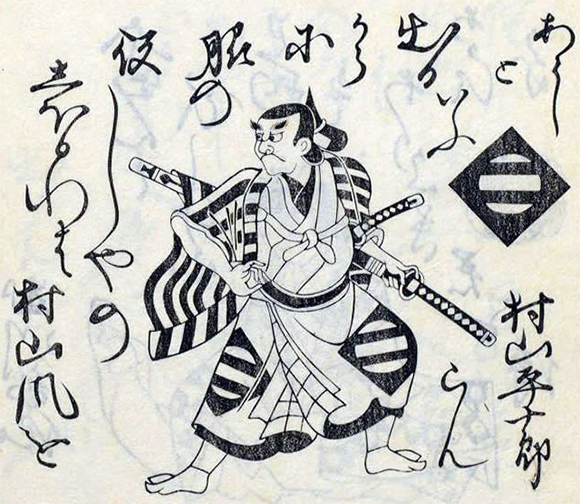| MURAYAMA HEIJŪRŌ I |
|
Stage name:
Line number: SHODAI (I) Existence: ??? ~ 8th lunar month of 1707 Connection: Master: Murayama Heiemon II Sons: Murayama Heijūrō II, Murayama Heijūrō III, Murayama Heijūrō IV Disciple: Murayama Jūheiji I Career: 1672: his name appeared for the first time in the Kabuki records, as a disciple of Murayama Heiemon II, who performed with his master in Kyōto. 3rd lunar month of 1685: Heijūrō went to Edo and performed at the Ichimuraza. 1688: Heijūrō went back to Ōsaka. 11th lunar month of 1689: Heijūrō performed in Ōsaka in the drama "Fujiwara no Haruhime", which was produced by Iwai Hanshirō I; his stage partners were Nakagawa Kinnojō and Uemura Kichiya II. 1st lunar month of 1690: Heijūrō performed in Ōsaka in the drama "Sakaba no Ōji", which was produced by Iwai Hanshirō I. 3rd lunar month of 1693: Heijūrō performed in Ōsaka in Chikamatsu Monzaemon's drama "Butsumo Mayasan Kaichō", which was produced by Iwai Hanshirō I and starred the actors Sugiyama Kanzaemon I and Iwai Sagenta I; this production was a success and a long run (150 days). The same play was simultaneously staged in Kyōto at Miyako Mandayū's theater. 1694: Heijūrō became zamoto and produced in Ōsaka the drama "Wakoku Fūryū Kyōdai Kagami", in which he played the role of Soga Gorō Tokimune; his stage partners were Takeshima Kōzaemon I (Soga Jūrō Sukenari), Nishikawa Okanosuke (Jūrō's lover Ōiso no Tora) and Hayama Heiemon (the Soga brothers' mother). 11th lunar month of 1695: Heijūrō went to Edo and performed at the Moritaza. 26th day of the 12th lunar month of 1695 [1]: a fire broke out in the district of Sukiyabashi, which burns the Moritaza to the ground. 1st lunar month of 1696: Heijūrō played at the Yamamuraza the role of Fuwa Banzaemon in the drama "Fuwa Nagoya Uikamuri"; the role of Nagoya Sanza, Banzaemon's rival in love, was played by Nakamura Shichisaburō I. Winter 1698/1699: Heijūrō went back to Ōsaka. 1st lunar month of 1699: Heijūrō's rank in the Ōsaka hyōbanki was jō (superior) [visual]. He performed in Ōsaka in Tsuuchi Jihź I's drama "Taisanji Yakushi no Kaichō", which was produced by Iwai Hanshirō I. 4th lunar month of 1699: Heijūrō played in the same theater the role of Taira no Masakado in the drama "Ryūjo Tsuya Oshiroi", which was produced by Iwai Hanshirō II; the role of Masakado's enemy Tawara no Tōta was played by Sakurayama Shōzaemon I. 1st lunar month of 1700: Heijūrō played the role of Moriya no Daijin in the drama "Onna Chōteki Sangoku Denraiki", which was produced in Ōsaka at the Kita-Horie Ichi-no-Gawa Shibai (Ōsaka) by Araki Yojibź I. 1st lunar month of 1701: Heijūrō played in Ōsaka the role of Tawara Magosaburō in the drama "Keisei Tamazusa no Miei", which was produced by Arashi San'emon II. 3rd lunar month of 1701: Heijūrō's rank in the Ōsaka hyōbanki, tachiyaku section, was jō-jō (superior - superior) [visual]. Fall 1701: Heijūrō played in Ōsaka the role of Mochizuki Jūrozaemon in the drama "Nagori no Sakazuki", which was produced by Arashi San'emon II. 1st lunar month of 1704: Heijūrō played in Ōsaka the role of Abe no Munetō in the drama "Azuma Mondō", which was produced by Kataoka Nizaemon I [2]. 11th lunar month of 1704: Heijūrō became zamoto in Ōsaka. 1st lunar month of 1705: Heijūrō produced in Ōsaka the new year drama "Miura no Ōsuke Hyakuhaimaru". 2nd lunar month of 1705: Heijūrō's rank in the Ōsaka hyōbanki was jō (superior) [visual]. 2nd lunar month of 1706: Heijūrō produced in Ōsaka the drama "Washi no Oyama Kaichō". Fall 1706: Heijūrō went to Kyōto. 11th lunar month of 1706: Heijūrō performed at Kameya Kumenojō's theater. 3rd lunar month of 1707: Heijūrō's rank in the Kyōto hyōbanki, tachiyaku section, was jō-jō (superior - superior) [visual]. 8th lunar month of 1707: he was supposed to go to Edo with Murayama Heiemon III and received 50 ryō for the trip. He suddenly died and his son Murayama Kinjūrō (the future Murayama Heijūrō II) replaced him. Comments: Murayama Heijūrō I was a good tachiyaku actor, who was active from the 1670s to the 1700s. He was more a katakiyaku in his prime but definitively switched to tachiyaku roles in 1699. He was said to be better in jidaimono than in sewamono and was endowed with a powerful voice. He had three sons and all his sons held the name of Murayama Heijūrō [3]. [1] The 26th day of the 12th lunar month of the 8th year of the Genroku era was the 30th of January 1696 in the western calendar. [2] Kataoka Nizaemon I played the role of Munetō's brother Abe no Sadatō. [3] This is, as far as we know, the only case in Kabuki history. |
 |
|
Murayama Heijūrō I in an ilustration from the book "Kokon Shibai Irokurabe Hyakunin Isshu" (1st lunar month of 1693) The Murayama Heijūrō line of actors |
|
|
| Contact | Main | Top | Updates | Actors | Plays | Playwrights | Programs | Links | FAQ | Glossary | Chronology | Illustrations | Prints | Characters | Derivatives | Theaters | Coming soon | News |